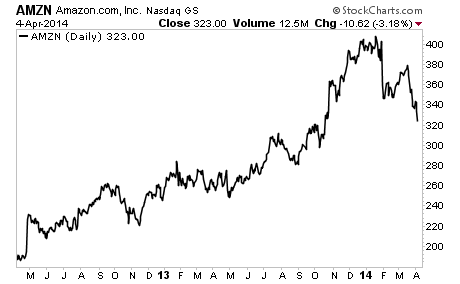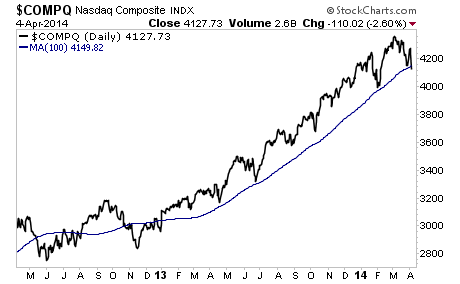| This morning I got a call to do a VERY early interview with CNBC Worldwide Exchange to discuss domestic employment and the string of "good" employment reports as of late. There are a couple of very important points to be made here with regards to employment data as it is reported. First, there is no real value in discussing one month's worth of employment. Whether we created 3,000 or 300,000 jobs is irrelevant if it is not put into context. Secondly, how we count, or should I say don't count, who is employed or not is also a very important issue. Just because we choose to exclude a certain group of people from the employment, does not mean that they are no longer relevant to the overall economic discussion. Therefore, let's put the recent employment reports, as reported the Bureau of Labor Statistics, into some form of context. The first chart below shows the net monthly increase in jobs on a seasonally adjusted basis. 
As you will see the economy has created roughly 204,000 jobs per month, each month, since the beginning of 2011. This looks "good" and is certainly an argument for the economic "bulls." However, let's add some context to this discussion. Employment is a function of demand by customers on businesses. As opposed to many economists and politicians, businesses do not hire employees to be "good samaritans." While such a utopian concept is fine in theory, the reality is that businesses operate from a "profit motive." Given that sales revenue has only grown by 4.3% a year since 2009, the aggregate demand on businesses has not been sufficient enough to expand employment dramatically. The immediate rebuttal to that statement is always, "yes, but look at corporate profits at all time highs." Corporate profits are another issue that is VERY misleading when taken out of context. Let me give you a very simplistic example to illustrate my point. Company XYZ sells a gadget for $1. The costs for manufacturing that gadget, all in, is $0.90 leaving a cash profit of $0.10. This is what the company now has "in the bank" from which to operate on. This is crucially important to understand. Companies operate from a cash basis. There are plenty of cases where "profitable" companies have gone out of business due to lack of operating capital from which to function. However, companies report profits, generally speaking, on an accrual basis. This allows for equal comparisons between companies on an operating basis as well as increase tax efficiencies, etc. Let's restructure our example: Company XYZ sells a gadget for $1 less expenses of $0.90. However, after amortization, one time writeoffs, depreciation, stock buybacks and other accounting manipulations, the net profit rises to $0.30 on an accrual basis. We can see this in "real time" by looking at the difference between sales (revenue) growth and operating profits on a per share basis for the S&P 500. (January, 2009 - December, 2013) 
Despite surging corporate profitability on an accrual basis, real consumer demand (as measured by what happens at the top of the income statement) is what drives the need for increased employment and capital expenditures. As I discussed recently in "It's Impossible To Replay The 90's" the consumer has likely reached "peak consumption." It was the 'borrowing and spending like mad' that provided a false sense of economic prosperity. The problem with this is clearly shown in the chart below. 
In 1980, household credit market debt stood at $1.3 Trillion. To move consumption, as a percent of the economy, from 61% to 67% by the year 2000 it required an increase of $5.6 Trillion in debt. Since 2000, consumption has increased by just 1% over the last 13 years. That increase in consumption required an additional increase $6.1 Trillion in personal debt. The importance of that statement should not be dismissed. It has required more debt to increase consumption by 1% of the economy since 2000, than it did to increase it by 6% from 1980-2000. The problem is quite clear. With the consumer heavily leveraged, the inability to "spend and borrow" is reducing aggregate demand. As stated, the current level of aggregate demand simply isn't strong enough to offset the rising costs of taxes, benefits and healthcare (a significant consideration due to the onset of the Affordable Care Act) associated with hiring full-time employees. Therefore, businesses initially opt for cost efficient productivity increases, and only hire as necessary to meet marginal increases in customer demand which as come from population growth. As the number of people in the economy expand, they demand more in the form of services. This leads to incremental increases in the need for waiters, airline attendants, bartenders, hospitality staff, etc. This is why the bulk of hiring continues to be primarily focused in these areas. (Unfortunately, these are also the lower wage paying jobs.) We can see this clearly shown in the chart below which shows is simply the number of "full time jobs" as reported by the BLS as a percentage of the working age population. 
The next chart vividly shows that employment has been driven by the marginal increases in demand caused by population growth. 
Personally, I like to view economic data on an annualized basis. When viewing a singular data point there is no relevancy as to what has occurred previously. However, analyzing the annualized changes reveals the underlying "trend" giving context to the current data. When it comes to economic data, what we really want to know is whether the economy is getting stronger or not. The next chart tells the story of the relationship between the consumer, employment and business investment. 
When the data is viewed from this perspective the integral relationship between the consumer and businesses is made quite clear. Employment and fixed investment both "react" to changes in personal consumption expenditures. This is why the calls for a surge in corporate fixed investment is likely not to materialize anytime soon to any great degree. With wages stagnant, social benefits comprising the largest share of disposable personal incomes on record and consumer indebtedness on the rise - there is precious little ability for "Main Street" to significantly expand consumption. While many blame the record low levels of labor force participation on the wave of retirees, the reality is that with nearly 80% of Americans living paycheck to paycheck many of these individuals are not actually retiring. As I stated previously, just because we no longer count millions of working age individuals, it does not make them any less relevant to the overarching discussion of why we continue to struggle with the slowest rate of economic growth in history. While there is much focus being placed on corporate profitability as a reason to push stock prices higher, there is a finite capability for companies to continue manufacturing bottom line earnings without significant increases at the topline. As previously discussed: Corporations continue to push the boundaries of wage and employment suppression, productivity increases and accounting gimmickry to support elevated profit margins. All of these functions are finite in nature, and despite much hope to the contrary, the current set of fundamental variables are more usually witnessed at the end of cyclical expansions rather than the beginning. 
What we find is that peaks in corporate profits margins have historically corresponded, not surprisingly, with peaks in equity markets. Since the media, analysts and managers push the "stocks are cheap" meme using linear extrapolation of earnings, it is the eventual reversion in earnings that lead to market corrections as expectations and reality collide. There is one last point to be made. Currently, there is a majority of analysts, and economists, "hoping" that businesses will suddenly step to the fore and begin a "spending rampage" to boost economic growth. While anecdotal evidence suggests this will not be the case, even if it comes to pass there is likely to be disappointment. Never in history has a segement that comprises 17% of GDP been able to pick up the slack for a segment that comprises 68%. It is function of math that will likely lead to eventual disappointment. | 

































